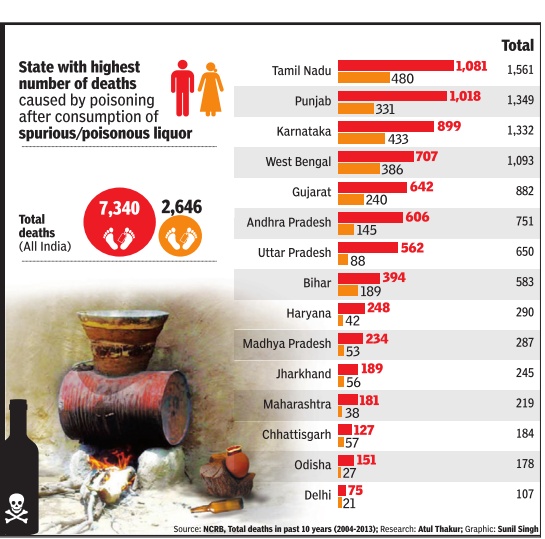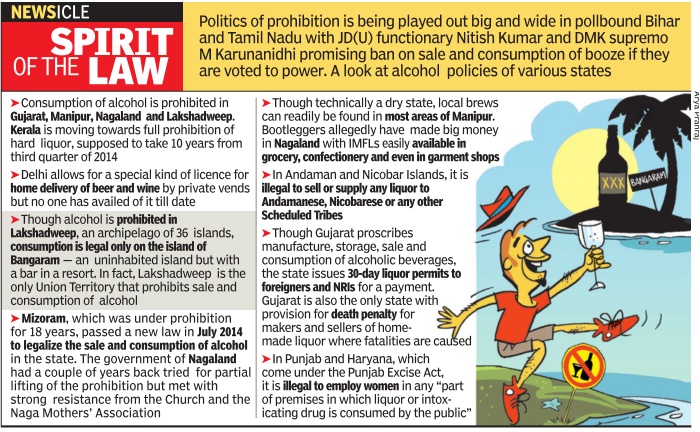Alcohol: India
m (Pdewan moved page Alcohol, illegal: India to Alcohol :India without leaving a redirect) |
|||
| Line 10: | Line 10: | ||
[[Category:India |A ]] | [[Category:India |A ]] | ||
[[Category:Crime |A ]] | [[Category:Crime |A ]] | ||
| + | |||
| + | =21.4% of Indians consume alcohol: United Nations Office on Drug and Crime (UNODC)= | ||
| + | [http://epaperbeta.timesofindia.com/Article.aspx?eid=31808&articlexml=DRUG-MENACE-RTI-214-of-Indians-consume-alcohol-27082015013060 ''The Times of India''], Aug 27 2015 | ||
| + | |||
| + | Dipak Dash | ||
| + | |||
| + | '''DRUG MENACE - RTI: 21.4% of Indians consume alcohol''' | ||
| + | | ||
| + | '' 3% of population hooked to cannabis '' | ||
| + | |||
| + | Punjab, Maharashtra, Manipur, Tamil Nadu and Andhra Pradesh are among the top 10 states where consumption of alcohol and narcotic drugs is higher than the rest of the country, according to a RTI response from home ministry. | ||
| + | |||
| + | Quoting a survey conducted by the United Nations Office on Drug and Crime (UNODC), the National Institute of Social Defence, a wing of MHA, has submitted that 21.4% Indians consume alcohol while 3% hooked to cannabis. The RTI was filed by a Delhi resident Ved Pal following recent cases of lives lost due to consumption of illicit alco hol in the country. | ||
| + | |||
| + | The RTI reply also mentions the list of 19 states and Union Territories that are in “major grasp“ of alcohol and drugs.Seven of these states are from north India including Delhi, Himachal Pradesh and UP . Except Arunachal Pradesh and Tripura, all other states from the northeast are in the list. | ||
| + | |||
| + | “Governments take the credit that they have earned crores of rupees through taxes and excise duty from the sale of alcohol.But governments should not be into this money making business. The entire amount that they have earned so far should be spent on creating awareness against consumption of alcohol and the rehabilitation of the addicts,“ Ved Pal said. | ||
| + | |||
| + | The UNODC study on “National Survey on Extent, Pattern and Trends of Drug Abuse in India“ that was released in 2004 had found that alcohol, cannabis and opiates are the major substances of abuse in India and the prevalence of drug abuse among males is significant. It had also found how women face the worst and are under huge burden if any member in their families is addicted to alcohol or drugs. | ||
| + | |||
| + | It had recommended the need to have schemes to attract drug users for treatment and developing programmes for vulnerable groups such as youth, street children and prisoners. | ||
=Poisonous liquor consumption, state-wise= | =Poisonous liquor consumption, state-wise= | ||
Revision as of 17:23, 28 August 2015


This is a collection of articles archived for the excellence of their content. |
21.4% of Indians consume alcohol: United Nations Office on Drug and Crime (UNODC)
The Times of India, Aug 27 2015
Dipak Dash
DRUG MENACE - RTI: 21.4% of Indians consume alcohol 3% of population hooked to cannabis
Punjab, Maharashtra, Manipur, Tamil Nadu and Andhra Pradesh are among the top 10 states where consumption of alcohol and narcotic drugs is higher than the rest of the country, according to a RTI response from home ministry.
Quoting a survey conducted by the United Nations Office on Drug and Crime (UNODC), the National Institute of Social Defence, a wing of MHA, has submitted that 21.4% Indians consume alcohol while 3% hooked to cannabis. The RTI was filed by a Delhi resident Ved Pal following recent cases of lives lost due to consumption of illicit alco hol in the country.
The RTI reply also mentions the list of 19 states and Union Territories that are in “major grasp“ of alcohol and drugs.Seven of these states are from north India including Delhi, Himachal Pradesh and UP . Except Arunachal Pradesh and Tripura, all other states from the northeast are in the list.
“Governments take the credit that they have earned crores of rupees through taxes and excise duty from the sale of alcohol.But governments should not be into this money making business. The entire amount that they have earned so far should be spent on creating awareness against consumption of alcohol and the rehabilitation of the addicts,“ Ved Pal said.
The UNODC study on “National Survey on Extent, Pattern and Trends of Drug Abuse in India“ that was released in 2004 had found that alcohol, cannabis and opiates are the major substances of abuse in India and the prevalence of drug abuse among males is significant. It had also found how women face the worst and are under huge burden if any member in their families is addicted to alcohol or drugs.
It had recommended the need to have schemes to attract drug users for treatment and developing programmes for vulnerable groups such as youth, street children and prisoners.
Poisonous liquor consumption, state-wise
The Times of India, Jun 23 2015
The recent hooch tragedy in Mumbai has claimed about 100 lives, perhaps the largest toll caused by consumption of spurious poisonous liquor for the city, crossing the toll of the 2004 Vikhroli incident which killed about 50 people. Data on deaths caused by spurious poisonous liquor shows that hooch has killed 9,986 people in India in the past decade. Tamil Nadu witnessed 1,561 deaths in this period, the highest in the country.It was followed by Punjab, Karnataka and West Bengal. Gujarat, which is a dry state, also witnessed about 900 deaths
Liqour prohibition rules
From the archives of India Today , July 27, 2008
Many states tried prohibition but had to backtrack later
• The Bansi Lal government kept its election promise and introduced prohibition in Haryana in 1996. But bordered by three states, implementing the policy became difficult, giving rise to liquor mafias. Besides, the state was losing about Rs 1,100 crore a year. The policy was repealed after only 21 months.
• The N.T.Rama Rao-led TDP government declared Andhra Pradesh dry in 1995 with a clear eye on the women’s vote but prohibition was repealed by his son-in-law N. Chandrababu Naidu who seized power following a family coup in 1997.
• Tamil Nadu, dry until 1971, went wet only to revert to prohibition in 1974.Repealed dry laws in 1981 and wet since.